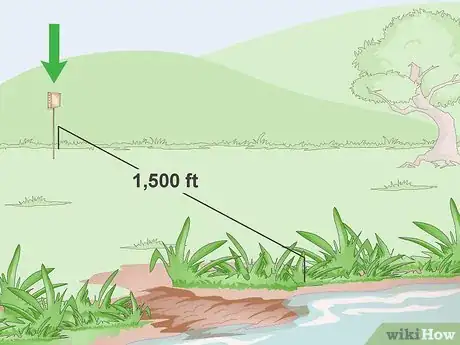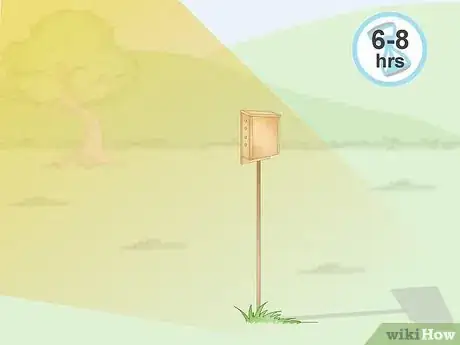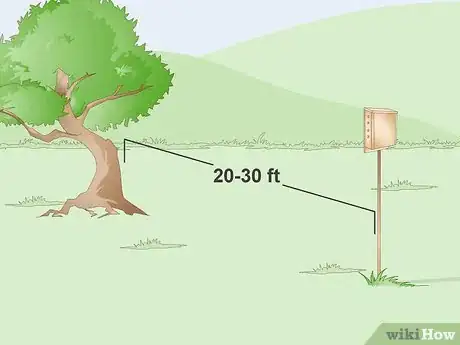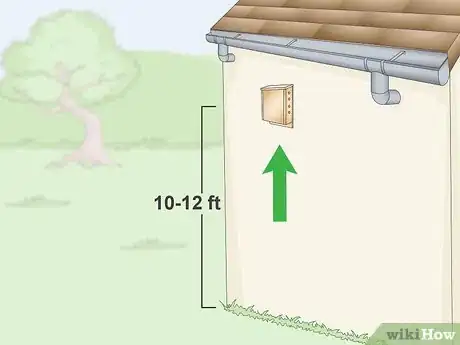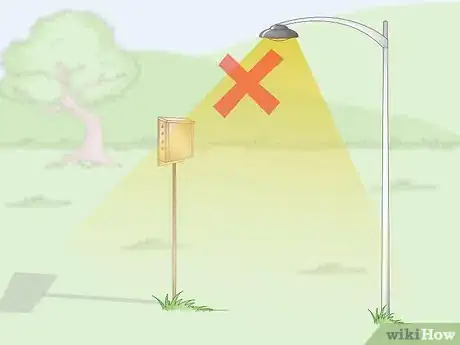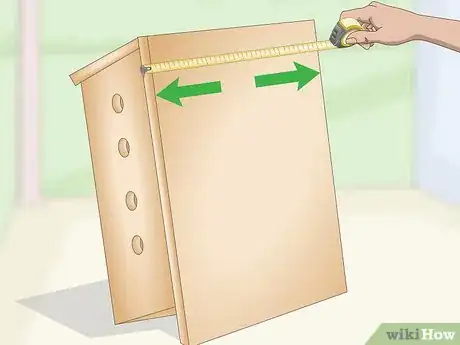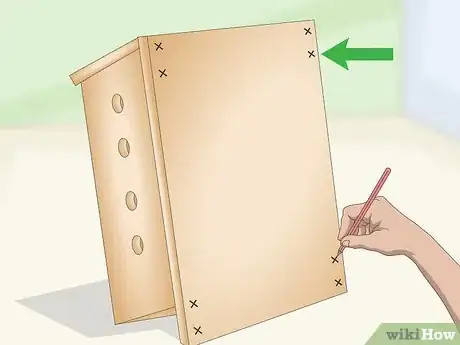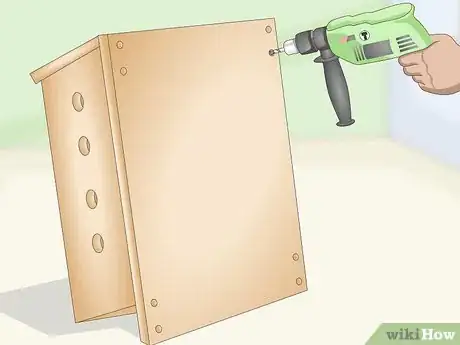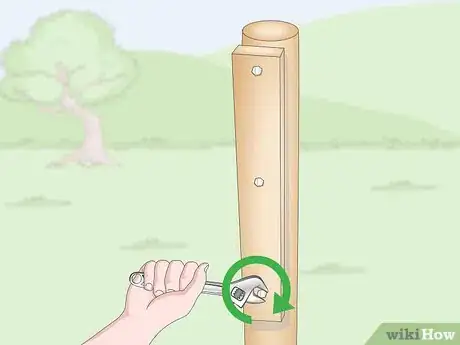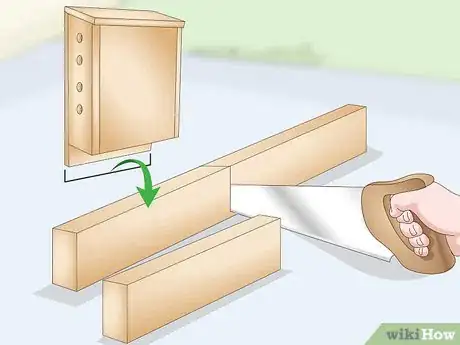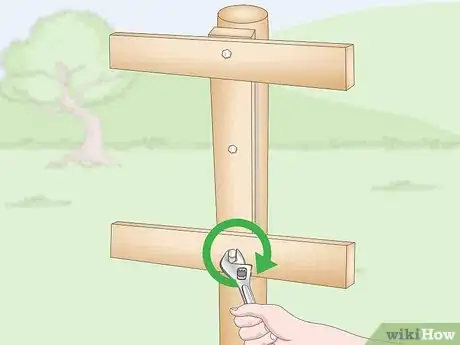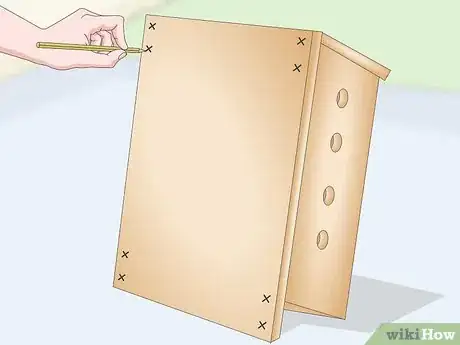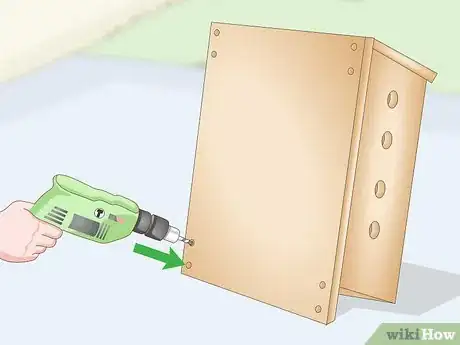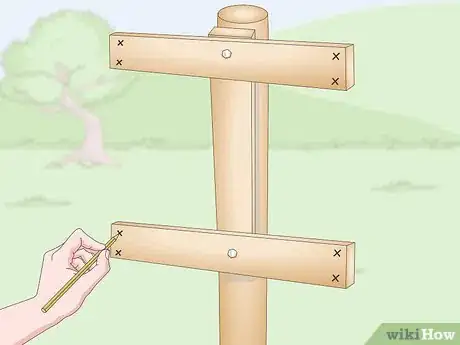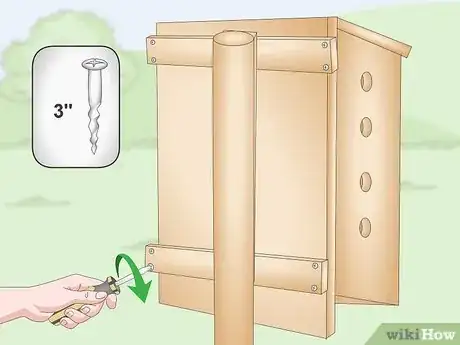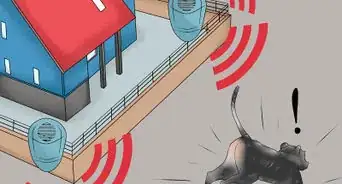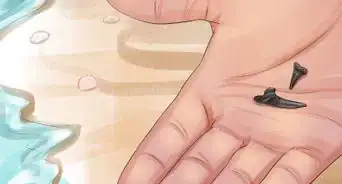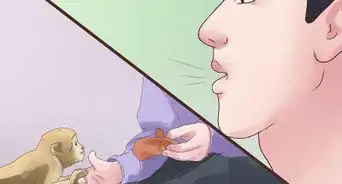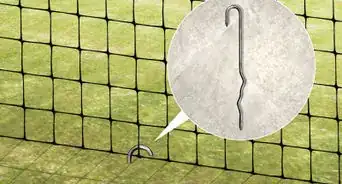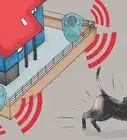This article was co-authored by wikiHow Staff. Our trained team of editors and researchers validate articles for accuracy and comprehensiveness. wikiHow's Content Management Team carefully monitors the work from our editorial staff to ensure that each article is backed by trusted research and meets our high quality standards.
wikiHow marks an article as reader-approved once it receives enough positive feedback. In this case, 95% of readers who voted found the article helpful, earning it our reader-approved status.
This article has been viewed 110,745 times.
Learn more...
During the summer months, many bats build nests in trees, beneath bridges, or even inside buildings. If you notice a lot of bats in your area, or notice a lot of bugs you want bats to get rid of, you may consider putting up a bat house for them to nest in. Choose a high location with a lot sun and build a mounting bracket from wood to hang your bat house.
Steps
Choosing the Right Location
-
1Pick a spot within 1,500 feet (460 m) of a body of water. Although bats can feed on any insects that fly around nearby, they need a reliable source of water to live. Most bats will only fly 1⁄4 mile (0.40 km) from a body of water to find a place to nest. Find a location with a river, stream, or even a pond nearby when picking somewhere to hang your bat house.[1]
- Some species of bats may fly further to find somewhere to nest, so an absence of water doesn’t necessarily mean your bat house will go unused.
- If you’re determined to lure bats to your bat house, make an artificial pond or another body of water in your yard to give the bats a reliable source of water.
-
2Choose a location that receives 6 to 8 hours of sunlight each day. Most bat houses will need 6 to 8 hours of sun each day in order to stay within the temperatures bats need to keep comfortable. Look for a location that faces East or South in an area that will be easily exposed to sun.[2]
- Bats like temperatures between 85 to 100 °F (29 to 38 °C), so try and maintain a temperature near this during the day.
- If you paint your bat house a darker color, such as black or a dark brown, it will make it more efficient at absorbing and retaining heat.
- If you live in a location that regularly exceeds temperatures of 100 °F (38 °C), place the bat house somewhere it will get less sun, or paint it a lighter color to reflect sunlight. It is more important that the internal temperature of the house is 85 to 100 °F (29 to 38 °C) than that it gets 6 to 8 hours of sunlight.
Advertisement -
3Keep the house 20 to 30 feet (6.1 to 9.1 m) from trees or bushes. Animals that prey on bats, such as owls, can perch in nearby trees and wait to catch bats as they enter or leave the house. Find a wall or a spot in your yard that’s at least 20 feet (6.1 m) from nearby trees to prevent animals from preying on the bat house.[3]
- As with the distance to water, you don’t need to measure out the distance from the trees to your bat house.
-
4Select a location 10 to 12 feet (3.0 to 3.7 m) off of the ground. Bats will fly into the bat house from the bottom, meaning you need to give them plenty of space to maneuver in. Pick a location on a wall of your home that is at least 10 feet (3.0 m) off of the ground to hang your bat house.[4]
- Putting the bat house high off the ground also helps prevent predators on the ground, such as cats and dogs, from being able to hunt the bats.
- If you can't find a perfect location on a pre-existing wall, you can erect a post in your yard to hang the bat house from. Make sure to use a post that is 13 to 15 feet (4.0 to 4.6 m) long so that it will still be at more than 10 to 12 feet (3.0 to 3.7 m) high once one end is buried in the ground.
- If you are using a wooden post, wrap it with a piece of sheet metal 18 inches (46 cm) high roughly 3 feet (0.91 m) off of the ground. This will stop predators from being able to climb the post.
-
5Avoid anywhere with artificial lighting. Bats are nocturnal, meaning they’ll nest in the bat house during the day and fly at night. In order to avoid disturbing them during the day or confusing them when it’s nighttime, make sure the location you pick is away from any artificial lighting. Choose a location far away from street lamps or yard lights.[5]
Mounting the Bat House to a Wall
-
1Measure the width of your bat house to plan the mounting brackets. Your mounting bracket will need to be wider than the bat house so that it can be attached to a wall. As a rough guide, measure the width of the bat house and add roughly 6 inches (15 cm) to its length to find the required size of your brackets.[6]
- The excess wood on either end of your brackets needs to be drilled into something sturdy, such as a stud in your wall. You may need to add more than 6 inches (15 cm) to ensure that you can drill through the bracket into something solid.
-
2Cut 2 pieces of 1 by 4 in (2.5 by 10.2 cm) wood to length. Measure out 2 lengths of 1 by 4 in (2.5 by 10.2 cm) wood to be the required size of your mounting brackets. Mark the length with a pencil and use a handsaw or something similar to cut through it. This should create 2 evenly sized wooden mounting brackets.[7]
- The brackets do not need to be exactly the same length, as long as they are bigger than the measurements you noted.
- It is possible to mount the bat house with only 1 bracket, but this will make it less secure and increase the chances of it falling when bats are inside.
-
3Mark 4 pilot holes evenly across the back of the bat house. The pilot holes need to be evenly spaced and marked on the back edges of the side panels of the bat house, so that the screws go into the sides rather than through the back paneling. Mark 2 points roughly 1 inch (2.5 cm) from the top of the house on each edge. Mark a second point 2 inches (5.1 cm) below it, before repeating the same process near the bottom of the bat house.[8]
- You should have 2 sets of 4 pencil marks across the very edges of the back of your bat house. These are the points that you will drill into to mount the house to your wall.
- By drilling into the sides of the house rather than the back wall, you’ll prevent exposed screws from penetrating the inside of the house where bats will nest.
-
4Drill pilot holes into the bat house. Pilot holes ensure that the screws will go into the wood of the bat house safely and easily. Attach a 3⁄32 in (0.24 cm) drill bit to an electric drill and use it to drill into the spots you marked on the back of the bat house.[9]
- As long as the size of the drill bit, and therefore the size of the pilot hole, is smaller than the screw you’ll be using to mount the house, your pilot holes will work perfectly.
-
5Copy the pilot holes to the middle of your wooden brackets. Measure the distances between each of the pilot holes you’ve drilled into the back of the bat house. Use the same measurements to mark and drill pilot holes all the way through your wooden brackets, so the two brackets can be placed over the bat house and the pilot holes will perfectly line up.[10]
- You should be able to look through each of the holes in each bracket and line it up with a hole on the bat house.
-
6Screw the wooden brackets onto the bat house. Place the 2 wooden brackets onto the back of the bat house so that the pilot holes are lined up. Use 8 1 1⁄2 in (3.8 cm) wood screws to hold the 2 brackets to your bat house, screwing them in and tightening them with a screwdriver.[11]
- Use a wooden clamp to hold the brackets to the bat house while you work. This will keep them from moving as you screw them in place.
- Use an adhesive caulk or something similar to hold the brackets in place while your screw in the wood screws to make sure everything holds firm.
-
7Attach the bat house to your wall with wood screws. Use a ladder and lift the bat house up to the section of your wall where you want to hang it. Get someone else to hold the house in place and use 8 2 in (5.1 cm) wood screws to drill through the exposed edges of the wooden bracket into your wall. Use 2 screws on each length of the exposed bracket to hold the house securely.[12]
- For extra ease in screwing the house onto the wall, drill some pilot holes in the exposed areas of the bracket first.
- Make sure your ladder is on even ground and that someone else is holding it while you hang the bat house.
Mounting the Bat House to a Post
-
1Cut a piece of 2 by 4 in (5.1 by 10.2 cm) wood to the length of the bat house. This will provide a flat surface that you can attach the bat house to, rather than attempting to screw it directly onto the pole. Measure the height of the bat house and use a saw to cut a piece of 2 by 4 in (5.1 by 10.2 cm) wood to length.
- This will be used to build part of the mounting bracket. It doesn’t need to be exactly the right length, as long as the other pieces of wood are attached at the right distance apart.
-
2Use lag bolts to attach the wood vertically near the post. Hold the piece of wood against the top end of the post so that it faces in the direction you want your bat house to face. Use 3 3⁄8 by 3 in (0.95 by 7.62 cm) lag bolts or lag screws to attach the wooden mount to the face of the post. Screw them in until they are flush with the wood.
- Drill some pilot holes into the pre-cut length of 2 by 4 in (5.1 by 10.2 cm) wood to make inserting the lag bolts easier.
- Use an adhesive caulk or something similar to hold the wood in place while you screw in the lag bolts.
- Screw 1 lag bolt into the wood roughly 1 inch (2.5 cm) from the top, another 1 inch (2.5 cm) below that, and a final one 1 inch (2.5 cm) from the bottom of the wood.
- If you are attaching the mounts and the bat house to post that has already been erected, you'll need to use a ladder to reach the top. Make sure the ladder is on even ground and someone holds it steady while you work.
-
3Cut 2 pieces of 2 by 4 in (5.1 by 10.2 cm) to roughly the width of the bat house. These two pieces of wood will be used to hold the bat house to the mount attached to the wooden post. Measure the width of the bat house and add 2 inches (5.1 cm). Use a handsaw to cut two pieces of 2 by 4 in (5.1 by 10.2 cm) wood to this length.
- As with the previous piece of wood, these 2 mounts only need to be wider than the bat house. Don’t worry too much if they are slightly longer or a little uneven.
-
4Screw the 2 lengths of wood onto the post mount with lag bolts. Position 1 piece of the pre-cut wood so that it sits in front of and flush with the top of the post mount. Use a 3⁄8 by 3 in (0.95 by 7.62 cm) lag bolt to attach the length of wood to the post mount, making sure not to hit the lag bolt beneath it. Repeat with the other piece of wood so it is flush with the bottom of the mount.
- The lag bolts should be affixed in the center of the lengths of wood so that an even amount of wood protrudes out from either side. The wooden bracket should look like a capitalized letter “I” or a sideways “H”.
- To make it easier, drill pilot holes into the wood and the post mount before installing the lag bolts.
-
5Mark pilot holes along the back of the bat house. The pilot holes need to be evenly spaced and marked on the back edges of the side panels of the bat house, so that the screws go into the sides rather than through the back paneling. Use a pencil to mark 5 equidistant points along the top edge, before repeating along the bottom edge of the bat house as well.
- You should have 2 sets of 5 pencil marks spread along the back of the bat house.
- Make sure the other side of each mark is another piece of wood and that it doesn’t go into the interior of the bat house. If you drill into the interior of the house, a bat might hurt itself on the sharp end of the screw.
-
6Drill pilot holes into the back of the bat house. Attach a 3⁄32 in (0.24 cm) drill bit to the end of an electric drill. Place the drill over one of the pencil marks near the edge of the bat house and drill roughly 1 inch (2.5 cm) into it to create a pilot hole. Repeat to make another 7 pilot holes, excluding the 2 pencil marks made in the center of the bat house.
- Pilot holes drilled in the center of the bat house won’t be accessible through the wooden mount or the post, so they can be ignored. These marks are only useful in spacing out the other pilot holes.
-
7Copy the pilot holes to the horizontal wooden brackets. Measure the distance between each of the pilot holes in the back of the bat house, as well as their distance from the center. Working outwards from the center point of your 2 wooden brackets, use the same measurements to copy, mark, and drill matching pilot holes all the way through the horizontal brackets.
- Use a 3⁄32 in (0.24 cm) drill bit to make these pilot holes as well.
- The 8 pilot holes on the back of the bat house should match up perfectly with the 8 pilot holes drilled in the wooden mounts.
-
8Secure the bat house to the wooden mounts with 3 in (7.6 cm) deck screws. Position the bat house onto the wooden mount attached to the post and use several clamps to hold it in place. Working from behind the wooden mounts, begin screwing 3 in (7.6 cm) deck screws into each of the pilot holes to hold the bat house to the mounts.
- Make sure the screws are holding the bat house strongly and securely before removing the clamps.
- With some rope and a few people to assist, you could attach the bat house to the post before you erect the post itself. Mount the bat house, put one end of the post into the ground, and lift it up so the bat house is in the air.
Community Q&A
-
QuestionIs the end of April too late to hang a bat house in NH?
 LeahlovesGodTop AnswererNope! If you have it up in April, the bats still have time to use it in the summer or the following year. The earlier you get it up, the better. It can take 2 - 3 years for bats to come in some situations.
LeahlovesGodTop AnswererNope! If you have it up in April, the bats still have time to use it in the summer or the following year. The earlier you get it up, the better. It can take 2 - 3 years for bats to come in some situations. -
QuestionWhere do I put the guano, and what kind of food do they eat?
 LeahlovesGodTop AnswererIf the guano is accumulating, you could either start a compost or put it in a garbage can/bag outside so it doesn't make the house smelly. Bats eat moths, mosquitoes, and other insects. Some bats eat nectar or ripe fruit. The bats will find the foods themselves - no need to feed them!
LeahlovesGodTop AnswererIf the guano is accumulating, you could either start a compost or put it in a garbage can/bag outside so it doesn't make the house smelly. Bats eat moths, mosquitoes, and other insects. Some bats eat nectar or ripe fruit. The bats will find the foods themselves - no need to feed them! -
QuestionCan I hang a house in October in Louisiana? When should I start putting out feed?
 LeahlovesGodTop AnswererYou can still hang the bat house in October. Although spring may be preferable, if the bats are around and see it in autumn, they may be more willing to come in the summer. You don't need to put feed in them; bats catch their food, which consists of insects.
LeahlovesGodTop AnswererYou can still hang the bat house in October. Although spring may be preferable, if the bats are around and see it in autumn, they may be more willing to come in the summer. You don't need to put feed in them; bats catch their food, which consists of insects.
Things You’ll Need
Mounting the Bat House on a Wall
- Tape measure
- 1 by 4 in (2.5 by 10.2 cm) wood
- Handsaw or something similar
- Pencil
- Drill
- 3⁄32 in (0.24 cm) drill bit
- Adhesive caulk
- 1 1⁄2 in (3.8 cm) wood screws
- Screwdriver
- Ladder
- 2 in (5.1 cm) wood screws
Mounting the Bat House on a Post
- 4 by 4 in (10 by 10 cm) post, 14 feet (4.3 m) tall
- Tape measure
- Ladder
- 2 by 4 in (5.1 by 10.2 cm) wood
- Handsaw or something similar
- Pencil
- Drill
- 3⁄32 in (0.24 cm) drill bit
- Adhesive caulk
- 3⁄8 by 3 in (0.95 by 7.62 cm) lag bolt
- Screwdriver
- 3 in (7.6 cm) deck screws
References
- ↑ http://www.batcon.org/resources/getting-involved/bat-houses/install
- ↑ http://www.habitatforbats.org/bat-house-faq/
- ↑ https://sciencing.com/location-bat-houses-5768100.html
- ↑ https://www.batcon.org/pdfs/bathouses/InstallingYourBatHousebuilding.pdf
- ↑ https://www.mass.gov/guides/bat-houses
- ↑ https://www.batcon.org/pdfs/bathouses/InstallingYourBatHousebuilding.pdf
- ↑ https://www.batcon.org/pdfs/bathouses/InstallingYourBatHousebuilding.pdf
- ↑ https://www.batcon.org/pdfs/bathouses/InstallingYourBatHousebuilding.pdf
- ↑ https://www.batcon.org/pdfs/bathouses/InstallingYourBatHousebuilding.pdf
About This Article
To hang a bat house, choose a spot within 1,500 feet of a body of water that receives 6 to 8 hours of sunlight daily. The hanging location should be 10 to 12 feet off of the ground and 20 to 30 feet away from trees or bushes. Next, measure the width of the bat house and cut 2 pieces of wood at that length to create mounting brackets. Then, drill pilot holes evenly across the back of the bat house. Finally, line up the brackets with the pilot holes and fasten them on. For tips on securing the bat house at your chosen location, read on!
